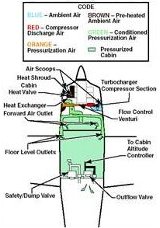
Auxiliary or secondary systems help the aircraft perform its main function: flying from a to b or a. They are necessary and important for a safe conduct of the flight although a failure of one of these systems would not cause the aircraft to loose control or crash immediately.
As you build your own aircraft you have the choice of installing these support systems yourself which entitles you to do your own maintenance, and having in-depth knowledge really helps should problems arise later on or during a flight.
Brakes & Wheels |
|
Stopping an aircraft is usually done with brakes on the main gear wheels only. And these wheels must roll without any undue internal friction, this means that the wheel bearings must be maintained and installed properly by the builder. |
|
Fire & Oxygen |
|
Most experimental aircraft do not have these systems but when flying above 10000 feet having extra oxygen on board can save lives. So is detecting possible engine fires especially when running with turbo-chargers or other hot running devices. |
|
Pitot Static System |
|
To be able to fly we need airspeed thus measuring and indicating the proper horizontal, vertical speed and altitude is important for safety. In this section we dive into these indicators and see how to convert static and dynamic air pressures into speed. |
|
Gyroscopic Systems |
|
When flying on instruments the pilot needs a precise and stable three dimensional indication of heading, attitude and turn. These are provided by vacuum or electric pumps and the indication by gyroscopic instruments in front of him. |
|
Hydraulics & Pneumatics |
|
Hydraulics and pneumatics systems are everywhere in the aircraft, from oil pumps, cabin pressurization to the brake systems, they all use Pascals Law. This is where we explain it so that you know enough to install and maintain them. |
|